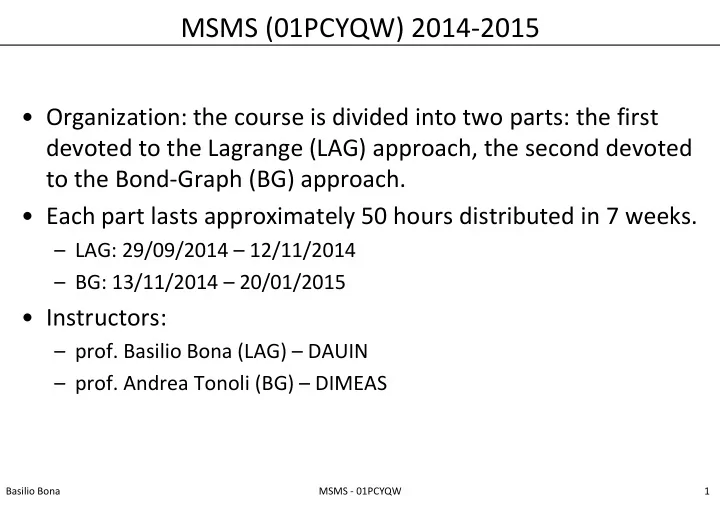

MSMS (01PCYQW) 2014-2015 • Organization: the course is divided into two parts: the first devoted to the Lagrange (LAG) approach, the second devoted to the Bond-Graph (BG) approach. • Each part lasts approximately 50 hours distributed in 7 weeks. – LAG: 29/09/2014 – 12/11/2014 – LAG: 29/09/2014 – 12/11/2014 – BG: 13/11/2014 – 20/01/2015 • Instructors: – prof. Basilio Bona (LAG) – DAUIN – prof. Andrea Tonoli (BG) – DIMEAS Basilio Bona MSMS - 01PCYQW 1
MSMS (01PCYQW) 2014-2015 • Exam Rules: the exam is written. It consists of two parts: – LAG part : one to three exercises (usually two); the exam lasts 1 h, 15 min; books and notes CAN be used. Examples will be given during the course. – BG part : one to three exercises (usually two); the exam lasts 1 h, 15 min; books and notes CANNOT be used. Examples will be given during the course. • The two parts can be taken together in the same exam session or separately in different sessions during the year. Basilio Bona MSMS - 01PCYQW 2
MSMS (01PCYQW) 2014-2015 • Lessons schedule Mon 13:00-14:30 room 1T Wed 08:30-11:30 room 2D Thu 14:30-17:30 room 10 • No Labs during the course • Textbook for the LAG part • Textbook for the LAG part B. Bona “Dynamic Modelling of Mechatronic Systems” B. Bona “Dynamic Modelling of Mechatronic Systems” CELID, 2013 (available at CELID, 2013 (available at CELID Bookstore) CELID Bookstore) • Web page for the LAG part http://www.ladispe.polito.it/corsi/meccatronica/01PCYQW/2014-15/ Basilio Bona MSMS - 01PCYQW 3
Examples Basilio Bona MSMS - 01PCYQW 4
Examples Basilio Bona MSMS - 01PCYQW 5
Why Modelling is necessary • Mode l ing = USA English – Mode ll ing = GB English • Models are required for – simulation, to predict future behaviour of systems – identification and parameter estimation, to find numerical values of unknown system parameters – control design, to write algorithms that enhance the system performance • Models can be developed as – Hardware models ... very rare today – Software models ... the most common type (MATLAB is the common choice) Basilio Bona MSMS - 01PCYQW 6
Necessary prerequisites • Vectors : what they are and why they are important • Matrix calculus : is the basic tool for representing physical concepts and for algorithms development • Physics : mainly basic concepts related to kinematics and dynamics (forces and torques) dynamics (forces and torques) • Basic notions of electrical circuits • MATLAB/SIMULINK not required for the exam but useful for the rest of the curriculum Basilio Bona MSMS - 01PCYQW 7
Other textbooks • LAG • LAG : Fundamentals of Applied Dynamics J.H. Williams, Jr. Wiley 1996 available at the Electronic Department Library • BG • • BG • BG : System Dynamics: A Unified Approach BG : System Dynamics: A Unified Approach D.C. Karnopp, D.L. Margolis, R.C. Rosenberg Wiley Interscience 1990 available at the PoliTo Central Library Basilio Bona MSMS - 01PCYQW 8
Topics – Lagrange method • Reference Frames and Roto-translations • Rigid Body Kinematics • Rigid Body Dynamics – Point Mass and Distributed Mass System – Mathematical Formulation • Rotation of the reference frame • Principal inertia matrix • Parallel axes theorem • Parallel axes theorem – Angular momentum and Euler Equation – Virtual Work Principle – Lagrange Equations in Mechanical Systems • Kinetic energy and co-energy • Potential energy • Generalized forces in holonomic systems • Lagrange equations with holonomic constraints • Lagrange equations with non holonomic constraints • Characterization of the Lagrange equations Basilio Bona MSMS - 01PCYQW 9
Topics – Lagrange method • Electrical Systems Dynamics – Lagrange method • Electromechanical Systems Dynamics – Lagrange method • State variables and state equations To test your initial state, please follow this link http://www.ladispe.polito.it/corsi/meccatronica/01PCYQW/201 4-15/Slides/01PCYQW%20Initial%20Test%202014-2015.pdf and try to answer to the questions inside Basilio Bona MSMS - 01PCYQW 10
Lagrange function Kinetic (co-)energy Potential energy Virtual works Scalars Forces Velocities Linear Linear Angular Angular Vectors Positions = coordinates Linear Angular Basilio Bona MSMS - 01PCYQW 11
• Lagrange function • Energies • Virtual works • Velocities • Positions Basilio Bona MSMS - 01PCYQW 12
Recommend
More recommend